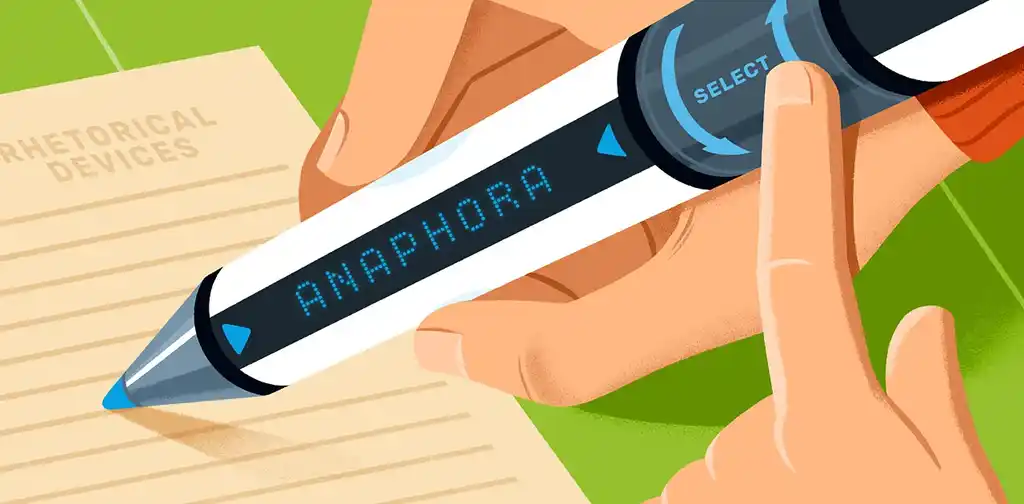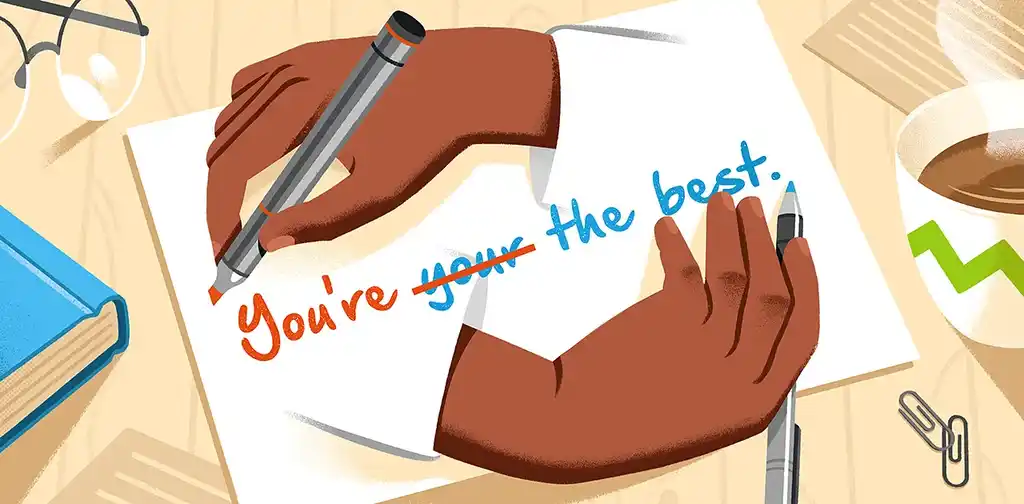
Reedsy's editorial team is a diverse group of industry experts devoted to helping authors write and publish beautiful books.
The editor-in-chief of the Reedsy Freelancer blog, Linnea is a writer and marketer with a degree from the University of Cambridge. Her focus is to provide aspiring editors and book designers with the resources to further their careers.
Let’s kick things off with a definition. Semicolons (;) are a type of punctuation used to link two complete and related sentences or clauses together. They can also replace coordinating conjunctions (and, or, but, etc.); they can separate list items, especially if the items on the list contain commas; moreover, they can be used together with conjunctive adverbs or transitional phrases such as “moreover,” and “in conclusion.”
Many people pause mid-sentence to wonder when to use semicolons. In this article, we’ll break down the grammatical role of the semicolon and show you how to decide when you should (or shouldn’t) use it in your own writing.
The semicolon often causes confusion among English speakers and writers. Typographically, it’s a combination of a period with a comma above it — resembling the regular colon. But that doesn’t mean you should pick at random, especially if you want to turn writing into a career or ace your academic work.
The reason that we have different punctuation marks is that they serve a distinct purpose in written communication.
The regular colon consists of two periods on top of each other and is commonly used to give emphasis; introduce a point, a topic, or a list; present spoken text, especially in interview format; or to add an explanatory subtitle to a work or composition, like a book. For example:
Emphasis or definition: The hero had one goal in mind: defeat all evil.
Introduce a point, topic, or list: The hero’s success depended on three things: slaying the dragon, bringing down the corrupt ruler, and breaking the magic spell.
Present dialogue:
Reporter: What made you set out on your quest?
Hero: It was a matter of necessity and storytelling traditions.
Add a subtitle: You can read more about the hero’s adventures in “The Hero’s Journey: An Age-old Battle Against Evil.”

How to Write Believable Dialogue
Master the art of dialogue in 10 five-minute lessons.
Colons are used when there’s a strong bond between what comes before and what comes after, and the two parts may be unable to stand on their own. You can consider them as two equally important parts of a sentence that complete each other.
🤔 Wondering how capitalization works when you’re using colons and semicolons? If what follows the colon is a fully-functioning, independent clause or part of a title, you should capitalize, whereas you shouldn’t capitalize if the two parts of the sentence are dependent on each other. With semicolons, capitalize the word that follows only if it’s a proper noun. Head over to our post on title capitalization rules if you want to learn more.
The symbol for the semicolon combines a comma and a period, and is used when the former feels insufficient (or grammatically incorrect) and the latter too final. There are instances when a semicolon is strictly necessary, and others when it is optional. Most commonly, it has four main uses:
Independent clauses: Next summer, I’m going to the Mediterranean again; I crave sunshine and good food.
Replacing coordinating conjunctions: I did my homework in time; (but) my sister did not finish hers.
Serial lists: Some of my favorite places to visit in summer include Rome, Italy; Athens, Greece; and Barcelona, Spain.
With conjunctive adverbs/transitional phrases: She is very pretty; more importantly, she’s smart as hell.
Semicolons are used when two things are related to each other but could still stand on their own, or to separate complex lists. Let’s take a closer look at the four functions of the semicolon to get a better understanding:
Since one of the major uses for semicolons is to separate two independent clauses from each other, we need to start by clarifying what independent clauses are and how they differ from dependent clauses.
Independent clauses are clauses that could function on their own as complete sentences. In English, they need to contain at least a subject and a verb and express a complete thought. “I smile,” for instance, is a complete sentence which contains a subject (I) and a verb (smile), and can stand on its own.
To join up two independent clauses, you need to use a semicolon:
Correct: I smile; I am happy.
Incorrect: I smile, I am happy.
☝️ Note: Some people would argue that you could use a colon here, saying: “I smile: I am happy.” This isn’t grammatically incorrect, but it is more common in British English than American English. For easier decision-making, we suggest you just stick to semicolons when linking independent clauses.

Dependent clauses, on the other hand, depend on the other parts of the sentence to function. They also contain a subject and a verb of their own, but do not express a complete thought. “When I smile,” contains a subject and a verb, for instance, but is not complete on its own.
To complete a dependent clause, use a comma, not a semicolon:
Correct: When I smile, I am happy.
Incorrect: When I smile; I am happy.
If you’re not sure whether clauses are independent or not, we’ve got a hack for you.
One simple way to check whether you’re dealing with two independent clauses and could use a semicolon is to check whether you can create two complete sentences by inserting a period.
Correct: Next summer, I’m going to the Mediterranean again; I crave sunshine and good food.
Correct: Next summer, I’m going to the Mediterranean again. I crave sunshine and good food.
This example works fine as two complete sentences, but using a semicolon highlights that they relate to each other. It is not so much a case of creating emphasis, but rather stacking two things on top of each other to provide further explanation or evidence. You could use a colon (though we don’t advise it), but remember that you cannot use a comma for independent clauses:
Incorrect: Next summer I’m going to the Mediterranean again, I crave sunshine and good food.

Let’s see how this works with another example we used earlier. The sentence “The hero had one goal in mind: defeat all evil” consists of two independent clauses too, so why did we use a colon and not a semicolon or period? The answer is context. Both “The hero had one goal in mind” and “Defeat all evil” could stand on their own as complete sentences, the latter being an imperative (issuing an order). However, since the author is trying to define and emphasize exactly what the goal of the hero is, a colon is the most appropriate punctuation in this situation.

Using a semicolon to combine two independent clauses suggests that two complete thoughts are related to each other — though not as closely as a colon would suggest — and of equal importance. It brings their meanings closer to each other in relation than if they were separated by a period, and also suggests that readers should insert a pause longer than a comma, but shorter than a period.
Authors can use this to achieve a neutral tone or make implicit suggestions about how two things relate to each other. As mentioned earlier, you can also use the semicolon to provide more information, explanation, or evidence of what you said in the first clause. Take this example from The Fellowship of the Ring:
“All that is gold does not glitter,
Not all those who wander are lost;
The old that is strong does not wither,
Deep roots are not reached by the frost.”
― J.R.R. Tolkien
Here, Tolkien is stacking separate imagery, suggesting that they relate to each other. This allows him to elaborate on the idea that things are not always as they seem, without having to explicitly state how the statements relate to each other, leaving it up to the reader to interpret.
Of course, the format of poetry is a bit of an outlier because of how it plays with language and meaning, so here’s another example:
“Logic will get you from A to Z; imagination will get you everywhere.”
― Albert Einstein
Here, Einstein is implying that there’s a contrast between logic and imagination and what results you’ll get from applying them. By juxtaposing them with the semicolon, he’s insinuating that both are valid, though imagination is perhaps the most important of all.

Find out which of today's greats is your writerly match. Takes one minute!
Another use for the semicolon is to replace coordinating conjunctions — the glue that otherwise keeps independent clauses together and shows causality, contrast, or relation. Some common ones are “and,” “but,” “or,” “so,” “yet,” “for,” and “nor,” and these little words tell readers or listeners how to order — or coordinate — sentences and clauses in relation to each other.
When you replace a coordinating conjunction with a semicolon, the connection generally needs to be clear and immediately obvious to the reader, especially if you’re writing factual works like academic essays or nonfiction books. You cannot use a semicolon and a coordinating conjunction together in this type of situation.
Correct: I saw your sister in town yesterday, but she didn’t notice me.
Correct: I saw your sister in town yesterday; she didn’t notice me.
Incorrect: I saw your sister in town yesterday; but she didn’t notice me.
From the context of the sentence, we can already tell that there’s a contrast between seeing the sister and being noticed, so we can safely remove the “but” and use a semicolon instead.
Of course, if you want to write a more poetic piece and embrace ambiguity, you can also strategically place a semicolon between two independent clauses and let your readers reach their own conclusions about how they relate to each other.
Spring came early this year; tears kept filling my eyes.
Is the author sad because of or despite the fact that spring came early? Perhaps they associate spring with something tragic or are missing someone who could not join them to appreciate its bloom. Or maybe the author is simply suffering from pollen allergies. It’s up to the reader to interpret.

Next, let’s look at a situation when you can use semicolons and coordinating conjunctions together.
Normally, you cannot use a semicolon and a coordinating conjunction together. The exception to this rule is if the semicolon makes the sentence easier to read, like if you’re writing serial lists with many commas:
You can use a semicolon to separate independent clauses; replace coordinating conjunctions, such as “and,” for similarity, “but,” for contrast, and “so,” for causality; and to separate long, complicated lists which contain many commas.
Notice how there’s an “and” after the last semicolon in this long, complicated sentence. In this case, we’re not really dealing with independent clauses so keeping the coordinating conjunction is necessary. Here, the semicolon is not introducing anything, so cannot be replaced by a colon. Instead, it serves to clearly demark each entity in the list and make it more readable at a glance.
Semicolons can also be used to link independent clauses that already contain a comma. For instance:
Correct: My brother is very clumsy. He often stumbles over roots, breaks things, and won’t look where he’s going; nor will he consider other people’s feelings when he speaks.
Incorrect: My brother is very clumsy. He often stumbles over roots, breaks things, and won’t look where he’s going, nor will he consider other people’s feelings when he speaks.
Using a comma in this case makes the sentence a bit more difficult to understand, so a semicolon, combined with the coordinating conjunction “nor”, is necessary to provide clarity.
In addition to making lists more readable, semicolons can also make sentences flow better when they’re combined with conjunctive adverbs.
You can use semicolons in front of conjunctive adverbs (also known as transitional phrases), replacing a period. These are words or phrases that make the text move along or transition smoothly. They are very common in argumentative or rhetorical texts, such as essays, where you’re trying to show a conclusion. Here are some common examples:
Conjunctive adverb/transitional phrase
Sample sentence
Semicolons can be used to link independent clauses; moreover, they can be used together with conjunctive adverbs or transitional phrases.
Grace went to the grocery store; however, she came back empty-handed.
Katy always had the best of intentions; nevertheless, she often ended up causing drama.
I love reading; also, I love watching Netflix.
He was a strict planner; consequently, he had a solution for every situation.
Tony was very superstitious; likewise, Maria always spat over her shoulder when she saw a black cat cross the road.
Paul dreamed of becoming a nurse; in contrast, Sara dreamed of becoming a surgeon.
For Christmas, Billy wished for a new toy car; in addition, he wanted the latest Avengers.
I never believed in fairy tales; in fact, I always thought they were nonsense.
Max liked to gamble; as a result, they lost all their savings.

Rhetorical Device Cheatsheet
Improve your powers of persuasion by mastering these 35 devices.
Semicolons are optional when you use conjunctive adverbs, and it’s up to you if you want to join up the two independent clauses or leave them as separate sentences. Note that a comma cannot be used, since these are independent clauses.
Incorrect: Katy always had the best of intentions, nevertheless, she often ended up causing drama.
Incorrect: Paul dreamed of becoming a nurse, in contrast, Sara dreamed of becoming a surgeon.
As with other independent clauses combined with a semicolon, this suggests that the two sentences are closer to each other than if they were separated by a comma, but the difference is often minimal.
Worried you won’t get it right on your own? Hire a professional proofreader to catch any misplaced punctuations.

The best copy editors, and proofreaders are on Reedsy. Sign up for free and meet them.
So, now that you know in what situations you could use a semicolon to stay on good terms with the grammar police, the question is whether you should. As a rule of thumb, remember to consider the context and use a semicolon only when it adds more clarity to your sentence and helps you better communicate what you’re trying to say.
You’ll often find semicolons sprinkled throughout academic papers and nonfiction writing, as authors try to demonstrate how two statements or arguments relate to each other — or try to avoid run-on sentences when things get a bit more complicated. As a bonus, since the semicolon allows you to remove coordinating conjunctions while keeping the meaning intact, it can help you meet a tight word count.
The issue is that the semicolon can provide clarity, but it can also make a text look a bit typographically busy and clunky — sometimes even counteracting its original purpose. For that reason, you’ll see fewer semicolons in creative writing, where it can seem a bit heavy-handed to use them too often. Some even argue that semicolons are a sign that you’re trying to do too much, resulting in overwritten and overwrought writing. Even if a semicolon might be grammatically correct or necessary, if there’s an easier way to say what you’re trying to say, that might be preferable. Compare:
With semicolons
Without semicolons
Hye-jin is a big foodie. She loves the comforting, spicy, sweet, umami flavors of her favorite Korean dishes from home; elegant, though hard to master, classic French cuisine; and, more than anything, creative and experimental fusion food at restaurants that combine the best of both worlds.
Hye-jin is a big foodie. She loves the comforting Korean dishes from home, with their spicy, sweet, umami flavors. At the same time, she enjoys elegant, classic French cuisine, even though it’s hard to master. But more than anything, she loves the creative, experimental fusion food at restaurants that combine the best of both worlds.
Both of these sentences are correct, so if you don’t have a pressing word limit, choosing to use a semicolon or rearrange the sentence comes down to author preference when you’re revising your draft.

Get our Book Editing Checklist
Resolve every error, from plot holes to misplaced punctuation.
It’s easy to get bogged down in grammar and forget that the main purpose of writing is to get what you’re trying to say across in the best way possible. Sometimes, the semicolon can help you achieve that. When it doesn’t, you might need to look at the sentence from a new angle. Happy writing! ;)
Recommended posts from the Reedsy Blog

Character creation can be challenging. To help spark your creativity, here’s a list of 100+ character ideas, along with tips on how to come up with your own.

Introducing characters is an art, and these eight tips and examples will help you master it.

Want a handy list to help you bring your characters to life? Discover words that describe physical attributes, dispositions, and emotions.

Need to plot your novel? Follow these 7 steps from New York Times bestselling author Caroline Leavitt.

Want to write your autobiography but aren’t sure where to start? This step-by-step guide will take you from opening lines to publishing it for everyone to read.

The climax is perhaps a story's most crucial moment, but many writers struggle to stick the landing. Let's see what makes for a great story climax.
Join a community of over 1 million authors
Reedsy is more than just a blog. Become a member today to discover how we can help you publish a beautiful book.